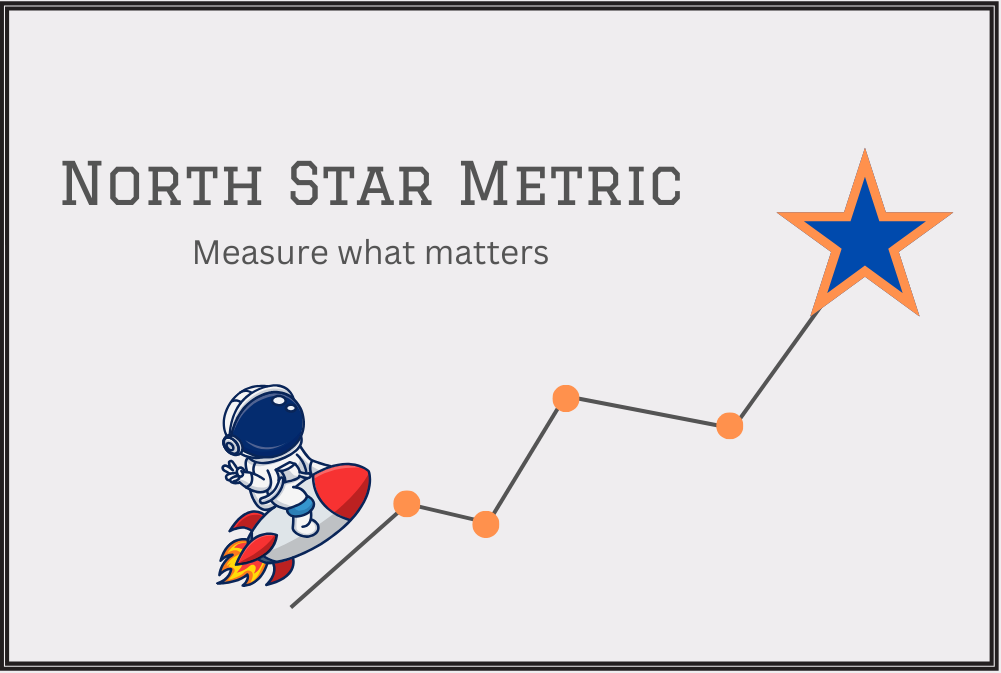|
Getting your Trinity Audio player ready...
|

Introduction:
Why did the product manager bring a compass to work?
Because they wanted to stay on course with their North Star Metric!
Jokes aside, in the world of product management, a North Star Metric is no laughing matter. It’s the guiding light that helps us steer our products in the right direction. But what exactly is this North Star Metric, and how can it keep us from getting lost in the vast sea of data? In this blog post, we’ll explore the concept of the North Star Metric and discuss how, as a product manager, you need to stay on top of data to make the best decisions for your product.
The North Star Metric: A Guiding Star
Think of the North Star as a lighthouse guiding ships safely to their destination. Similarly, the North Star Metric is like a guiding light for your product. It’s a single, crucial metric that captures the essence of your product’s success. This metric is not just about numbers; it’s about capturing the heart and soul of your product’s value proposition.
An Analogy: The Ice Cream Shop
Imagine you own an ice cream shop. Your North Star Metric might be the number of customers who return to buy ice cream every month. Why? Because it measures customer satisfaction, which is at the core of your business. If this metric goes up, it means more customers are happy with your ice cream and keep coming back for more.
Now, consider all the other data you have—like the number of flavors you offer, the price of your ice cream, or the weather in your area. While these are important, the North Star Metric helps you stay focused on what truly matters: customer satisfaction. It’s your lighthouse, helping you navigate through the storm of data.
Why Stay on Top of Data?
Data is the lifeblood of effective product management. It serves as the compass and the rudder, steering the product ship through the ever-changing tides of the market. Here’s why staying on top of data is paramount:
- Informed Decision-Making: Data is your guiding star in the night sky of product development. It provides the empirical evidence you need to make informed decisions. Without it, you’d be navigating blindfolded through a labyrinth of uncertainties. Imagine you’re the captain of a ship. Data is your map, showing you the treacherous rocks and the safe passages. Without it, you’d be sailing into the unknown.
- Course Corrections: Just as sailors use data on wind speed and direction to adjust their sails, product managers rely on data to make course corrections. If your North Star Metric starts to waver, it’s a sign that your product may be off course. Regular data analysis helps you identify deviations early and take corrective action. Think of your product as a ship sailing through stormy seas. Data serves as your radar, detecting potential obstacles and enabling you to navigate around them.
- Resource Allocation: Data empowers you to allocate resources effectively. Imagine your budget is a limited treasure chest, and your product initiatives are like islands in the vast ocean. Data helps you pinpoint the islands with the most potential for buried treasure, ensuring you invest your resources wisely. Just as a wise explorer allocates their resources to areas with the highest chances of treasure discovery, a product manager allocates resources where data indicates the greatest potential for success.
- Customer Insights: Data isn’t just about numbers; it’s about understanding your customers. By staying on top of data, you gain invaluable insights into your users’ behaviors, needs, and preferences. This knowledge is the key to delivering a product that resonates with your audience. Picture your data as a treasure trove of customer stories. Each data point is a clue to uncovering what your customers truly desire.
- Competitive Advantage: In a competitive market, data can be your secret weapon. By analyzing market trends, customer feedback, and competitor strategies, you can identify opportunities and stay one step ahead. Data is your spyglass, allowing you to peer into the strategies of your competitors and see the uncharted territories of market opportunities.
Remember, data is not just a tool; it’s your guiding star, your radar, your treasure map, and your spyglass in the world of product management. Staying on top of data is the key to setting a course for success and ensuring your product stays on track toward its North Star.
Side note: Going by my choice of words today (captain, ship, sailing, stormy seas, explorer, treasure map, spyglass, etc), I think it is high time I change my Captain Jack Sparrow wallpaper on my computer!
Examples of North Star Metrics:
To illustrate the power of North Star Metrics, let’s look at a few examples from well-known companies:
- Facebook: Facebook’s North Star Metric is the number of daily active users (DAU). This metric aligns perfectly with their mission to connect people. The more people use the platform daily, the more successful Facebook becomes.
- Netflix: For Netflix, their North Star Metric is subscriber retention. They want people to keep subscribing month after month. If retention rates are high, it means they are delivering content that keeps their audience engaged.
- Airbnb: Airbnb’s North Star Metric is the number of nights booked. This metric reflects the platform’s core value of helping hosts fill their available nights and guests find suitable accommodations.
These examples demonstrate how a North Star Metric can be a guiding light for a company’s product strategy and align with its overarching mission.
Challenge: Guess the North Star Metrics
Let’s test your product intuition by guessing the North Star Metrics for various companies, both well-known and less-known. Try to align each company’s mission with its key performance indicator and see if you are able to guess their North Star. Comment your answers and people with the right answers will get a bunch of LinkedIn profile views, I’m sure!
Company 1: Duolingo
Duolingo is a language-learning platform that offers free courses in multiple languages.
Company 2: Trello
Trello is a popular project management tool that helps teams organize tasks and projects.
Company 3: Canva
Canva is an online graphic design tool used by individuals and businesses to create various visual content.
The Danger of Data Overload

While data is invaluable, drowning in it can be counter-productive. Imagine trying to drink from a firehose—it’s messy and overwhelming. As a product manager, you need to strike a balance between collecting data and making sense of it. Think of your data as ingredients in a recipe. You need the right mix to create the perfect dish. Too much or too little can ruin the meal.
According to Marty Cagan, PMs typically spend the first 30 minutes of their data looking at data tools to understand what has been happening in the last 24 hours. That tells me – to make it a habit and not an obsession.
Conclusion: Setting Sail with Confidence
In the world of product management, the North Star Metric is your guiding star, your lighthouse in the storm of data. By staying on top of data, you can navigate through turbulent waters, make informed decisions, and ensure your product is on the right course. Just like a ship captain who relies on both the North Star and the changing winds, you can balance your North Star Metric with the data to set sail with confidence toward a successful product journey.
So, let your North Star shine brightly, and may your product always find its way to success!
Watch this space for more product management-related articles – engineering.rently.com
Get to know about Rently at https://use.rently.com/
Group Product Manager, Rently Smart Home

